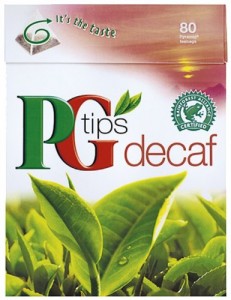Most of us tea lovers crave a satisfying cup of the real thing (as opposed to the herbal variety) in the evening; however, we avoid such an indulgence because caffeine tends to disrupt sleep. Decaffeinated options are available, but how do they taste? Is the decaffeination process safe, and how effective is it?
Can You Decaffeinate Tea Yourself?
Do-it-yourself instructions for decaffeinating tea are widely available on the Internet. The process is as follows: steep the tea for 30–45 seconds to release the majority of caffeine, drain the water, and steep again. Voilá, you have great tasting tea minus the caffeine.
But wait! As the dude (from the movie, The Big Lebowski) might say, “New sh*t has come to light, man.” The notion that most of tea’s caffeine can be removed by an initial 30–45 second steeping is just a widespread myth.
Firstly, it takes much longer that 30 seconds to remove the caffeine from tea — 15 minutes is more like it. Secondly, both the tea’s caffeine and flavor are released at the same time in water; when the caffeine’s gone, so is the flavor (click here and here for more information).
Commercial Tea Decaffeination Processes
In the United States, tea must have 98% of its caffeine removed to be sold as decaf. Three decaffeination methods exist today — all involve the use of solvents to extract the caffeine from the tea leaves. These solvents are as follows:
- Methylene Chloride: Also known as dichloromethane, trace amounts of this solvent remain in the tea leaves after decaffeination. Because large amounts of this chemical have been linked to cancer, many tea drinkers avoid tea decaffeinated this way. As of this writing, most teas are decaffeinated using methylene chloride.
- Ethyl Acetate: This chemical occurs naturally in tea. Although this decaffeination process is considered safe, much of the tea’s flavor is removed as a result.
- Carbon dioxide (CO₂): Considered to be the safest and least destructive to the tea’s original flavor, this decaffeination process involves pressurizing the CO₂ so that it liquifies. The carbon dioxide is then used as a solvent to remove the caffeine.
Sadly, many brand-name tea makers do not use the CO₂ process. For example, Unilever, the manufacturer of the popular PG Tips and Lyons brands, uses dichloromethane (according to this source) to produce its decaffeinated teas.
Tea manufacturers typically don’t place caffeine extraction information — especially if it involves ethyl acetate — on the packaging. If you are uncertain or concerned, simply contact the company via email.
Independent tea merchants, such as English Tea Store, Upton Tea Imports, and Adagio, are your best bet for finding CO₂ decaffeinated teas. If the carbon dioxide method is used, it will be proudly mentioned on the company’s website. English Tea Store, for instance, claims to remove the caffeine with CO₂ early in the process, at the green leaf stage, and then allows the tea to mature as usual.


Hi there, I log on to your blogs daily. Your story-telling style is witty, keep up the good work!
have been told decaff incredience includes anti freeze am i being fooled or is this true sincerely maureen hall
Equal Exchange uses the CO2 method and provides organic choices as well: http://equalexchange.coop/products/tea/faqs/how-is-the-caffeine-removed-from-decaf-english-breakfast
Is it because this was posted now 5 year’s ago because i noticed you did not write about the water method to decaf tea.
Twinings in North America says that it uses the ethyl acetate method (See: https://twiningsusa.com/pages/faqs — under General, Tea Related > “What is the decaffeinate process?”). I’ve tried their decaf Earl Grey tea and compared it to their caffeinated Earl Grey. While there is some reduction in flavor, it’s not too bad. It’s a brand that’s readily available, pretty good quality overall, and not too pricey.
Hi I am 69 and been drinking decaffeinated tea for probably the last 10 years but found I was thirsty after each cup. I decided that it may be causing my dehydration issues and need to be drinking so much water having had a kidney stone from the dehydration 18 months ago and ongoing gout issues! I gave up the D tea and within days noticed changes in my body such as sleeping the whole night without getting up to empty my bladder, the continual cracking of fingers easing off, the colour of my water so much clearer, no more thirstiness all the time, not a trace of gout even when trying to induce it by eating all my trigger food and also not having to live on hydrolyte tablets! Must have been the paint thinners! (Decaffeinating substance) No wonder they don’t advertise it!
Wow! That was helpful info. Thanks for the heads up.
I have been drinking Marks and Spencer decaff. tea for several years and have had no side effects other than getting up once or twice in the night.Many people I know say that they have headaches following drinking decaff. I have had some kidney problems which have disappeared since I began to drink decaff, tea so I am prepared to continue drinking it.I hope the tea companies will continue their research and work to produce better quality tea for everybody.
Joan Walker
Does anybody know the process that Red Rose uses to decaffeinate its tea ?
Thank you.
I buy most of my tea from Harney & Sons in NY. Here’s what they have to say:
https://youtu.be/J9uY8TKym7c?si=C21Wr82ob9XnOC1s
https://www.harney.com/blogs/news/tea-decaffeination-process
Their decaf Darjeeling is my go-to when I want to limit caffeine consumption.